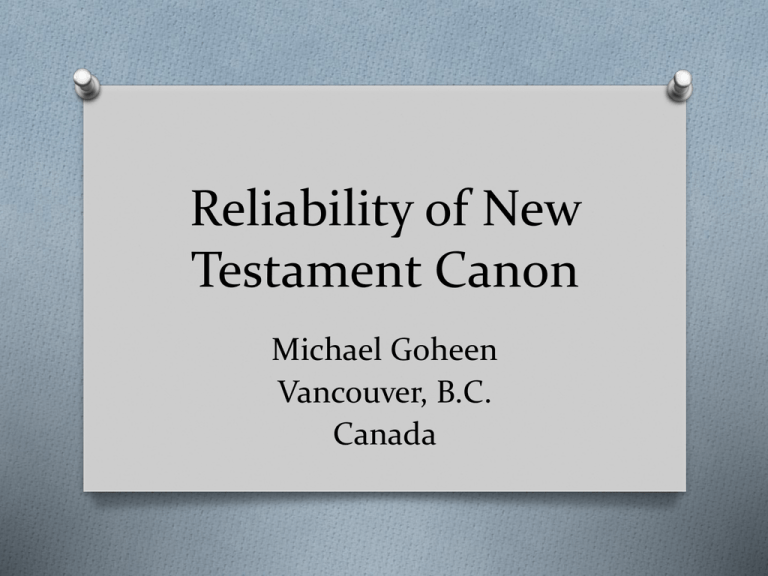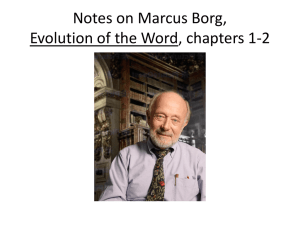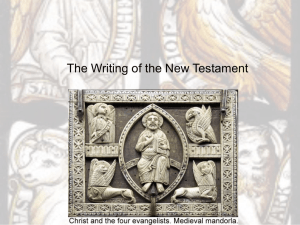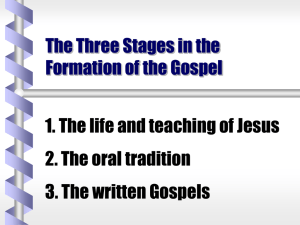Canon Powerpoint - City Life Church
advertisement

Reliability of New Testament Canon Michael Goheen Vancouver, B.C. Canada Starting with two texts O John 5.31-47: “These very Scriptures testify about me, yet you refuse to come to me to have life.” O John 10.22-42: “My sheep hear my voice.” v.27 New Origins of Christianity O Many documents about Jesus, some recently come to light, that gives us real Jesus O Four documents later and were canonised to give power to church O Jesus merely a religious teacher O Orthodox Christianity a mistake; time to give it up O Myth of neutrality, fairness, broadminded scholarship Jesus and the Old Testament O Old Testament is a story waiting for an ending O Luke 24: Jesus interprets story with him—his life, death, resurrection—as key O Christ-event fullest revelation of God and his purpose for world O First choice: Belief or unbelief in Christ It’s about faith in Christ . . . O Faith in Jesus means: O Embrace Old Testament story and canon O Adhere to redemptive-historical setting for emergence of New Testament canon God’s Revelation O God has chosen to reveal himself most fully in person and historical events (Heb 1.1ff.) O Eyewitness is only way historical events can be transmitted to those later O Believe or not—only choices God’s provision O Christ himself established authoritative eyewitness structure to transmit gospel to future generations—apostolate O Role unique and unrepeatable O Mark 3.14: Be with him Apostolate O Chosen by Jesus to give authoritative testimony (Acts 10.41) O Commissioned by Jesus for task (Jn 13.20) O Shaliach: Power of attorney in Jewish legal system O Empowered by Spirit to carry out task (Jn 14.26; 15.26-27; 16.13, 15) O Events and communication bound together in Jesus’ ministry Apostolic Tradition O Oral and written (2 Thess 2.13) O Jewish notion of tradition O Authoritative because of office (teachers of law) O Authoritative because of content (God’s word) O Language: Pass on, receive, hold firmly, retain (e.g., 1 Cor 15.1ff ) Nature of apostolic tradition O Kerygma: Proclamation of events with call for response (herald) O Marturia: Witness to events and true interpretation (law court) O Didache: Teaching about significance of those events for missional life of church (Rabbis) Apostolic tradition takes written form O So it could be accurately preserved and transmitted O New Testament indicates this (1 Cor 15.1-3; Lk 1.1-4) O Carries divine authority as word of God (1 Thess 2.13) God’s authority as canon is not limited to His great deeds in Jesus Christ but extends to their communication in the words and writings of those He specially chose and equipped to be the bearers and instruments of divine revelation, and the written tradition they established, in analogy with the writings of the Old Testament, thereby became the foundation and standard of the coming church. (Herman Ridderbos) Distinction O Theology and history of canon O How to understand authority of New Testament and corporate reception Initial Reception O Apostolic tradition has always been very life of the church O Majority of books recognised immediately early and widely used O Not conscious of questions of canon; recognised voice of Christ in these books (faith) Astonishingly early, the great central core of the present New Testament was already being treated as the main authoritative source for Christians. - John Barton Witness of Holy Spirit We can know the canonical books because of ‘the witness of the Holy Spirit given corporately to God’s people and made manifest by a nearly unanimous acceptance of the NT canon in the Christian churches.’ (Roger Nicole) ‘The Bible constitutes itself the Canon. It is the Canon because it imposed itself upon the Church.’ - Karl Barth Historical Process O We can expect the process to take some time O We can expect disagreement, diversity, difference of opinion O We can expect normal historical processes—decisions of key leaders, church deliberations, heretical challenge, various events Four categories O Recognised books: 4 Gospels, 13 Pauline letters, Acts, 1 Peter, 1 John, [Hebrews, Revelation] O Disputed books: James, Jude, 2 Peter, 2, 3 John O Rejected books: e.g., Shepherd of Hermas O Heretical books: e.g., Gospel of Thomas Consensus O Ultimate consensus around 27 books O How did this happen? O Ecumenical ties between world church O Powerful influence of undisputed, recognised books Some historical factors prompting closing canon O Montanists: Addition of prophetic books O Marcion: Reduced canon to Luke and 10 of Paul’s letters O Gnostics: Heretical “forgeries” Gnostic gospels O Books discovered at Nag Hammadi, Egypt 70 years ago O Dan Brown’s Da Vinci Code (Gospel of Thomas) O Discovery of Gospel of Judas O Work of radical scholars like Bart Ehrman, Elaine Pagels, etc. Gnostic Gospels O Demonstrably late O Demonstrably derived from canon O Demonstrably different from Jewish worldview and apostolic tradition Gnostic Belief O World is a wicked, dark place O Created by evil and capricious god O Salvation is to escape the evil world O Salvation comes by special revelation of secret knowledge from ‘revealer’ Apostolic Tradition O World is good: Creation is very good, incarnation, bodily resurrection, O Salvation is restoration of good creation: Bodily resurrection on restored earth O Gospels: Narratives of events and teaching O Jesus: Fulfilment of OT story Conclusions O Jesus is the fullest revelation of God and his salvific purpose for world O Accomplished in life, death, and resurrection of Jesus O Apostles appointed to testify authoritatively to these events Conclusions O Church lived out of written apostolic testimony as it received life from Jesus O ‘Self-attestation’ of books and ‘testimony of Spirit’ enabled church to hear voice of Shepherd Conclusions O Early consensus around most of books O Resolution came by ecumenical dialogue and power of gospel in recognised books O Taste and see








